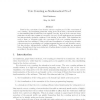Free Online Productivity Tools
i2Speak
i2Symbol
i2OCR
iTex2Img
iWeb2Print
iWeb2Shot
i2Type
iPdf2Split
iPdf2Merge
i2Bopomofo
i2Arabic
i2Style
i2Image
i2PDF
iLatex2Rtf
Sci2ools
AUSAI
2015
Springer
2015
Springer
Vote Counting as Mathematical Proof
Trust in the correctness of an election outcome requires proof of the correctness of vote counting. By formulating particular voting protocols as rules, correctness amounts to demonstrating that all rules have been applied correctly. A proof of the outcome of any particular election then consists of a sequence (or tree) of rule applications and provides and independently checkable certificate of the validity of the result. This eliminates the need to trust, or otherwise verify, the correctness of the vote counting software once certificate has been validated. Using a rule-based formalisation of voting protocols inside a theorem prover, we synthesise vote coating programs that are not only provably correct, but also produce independently verifiable certificates. These programs are generated from a (formal) proof that every initial set of ballots allows to decide the election winner according to the given rules.
| Added | 16 Apr 2016 |
| Updated | 16 Apr 2016 |
| Type | Journal |
| Year | 2015 |
| Where | AUSAI |
| Authors | Dirk Pattinson, Carsten Schürmann |
Comments (0)

